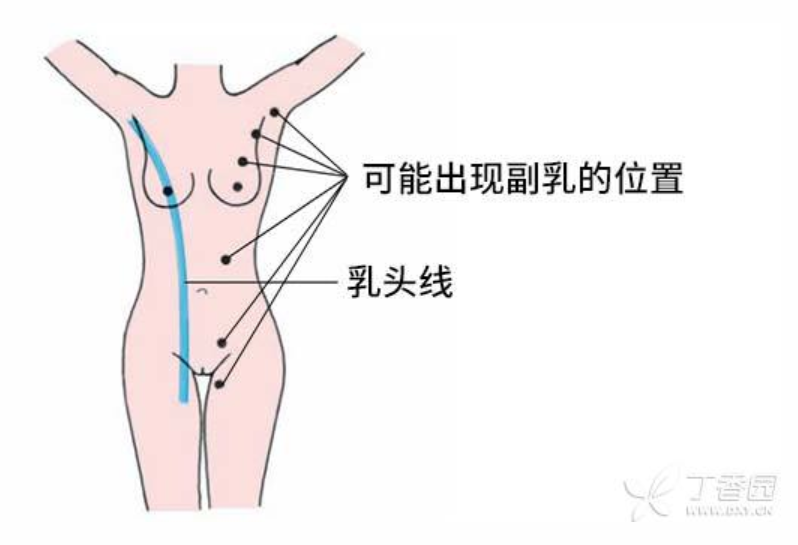Axillary breast tissue
SYMPTOMS
What are accessory breasts?
Normal breasts are located on the anterior chest wall, approximately between the 2nd and 6th ribs, with one on each side, composed of mammary tissue and nipples. Accessory breasts refer to the presence of breast tissue in locations other than the normal breasts, commonly found in the anterior axillary region or underarm. They can also occur elsewhere along the mammary ridge, such as the chest wall, abdomen, or groin. The incidence of accessory breasts is approximately 2.5%. Accessory breasts are smaller than normal breasts and are often mistaken for excess fat. Possible locations of accessory breasts are shown in the image below:

Both men and women can develop accessory breasts, though they are more common in women. Depending on their developmental stage, accessory breasts can be classified as complete or incomplete. Complete accessory breasts contain both mammary tissue and a nipple, while incomplete types include two variations: one with mammary tissue but no nipple, and another with only a nipple and no mammary tissue.
The formation of accessory breasts is related to abnormal regression of primitive mammary tissue. At birth, if primitive mammary tissue beyond the normal pair on the chest fails to regress, it may develop into accessory breasts. Patients should be aware that accessory breasts, like normal breasts, can develop breast-related conditions, such as hyperplasia, fibroadenomas, or even breast cancer, warranting sufficient attention.
TREATMENT
How to Improve or Treat Accessory Breasts?
-
In most cases, accessory breasts do not require special treatment. Maintaining a healthy lifestyle, avoiding frequent squeezing, and performing regular self-examinations are sufficient. However, if the patient feels it affects aesthetics or is concerned about potential cancer, surgical removal may be considered. Wearing shaping underwear is ineffective.
-
Additionally, patients should be aware that if symptoms such as pain, rapid enlargement, localized lumps, discharge, pus, or abnormal skin changes occur, they should seek prompt medical attention at a reputable hospital for proper diagnosis and active treatment.
DIAGNOSIS
Under what circumstances should patients with accessory breasts seek medical attention?
Patients with accessory breasts should seek immediate medical attention if they experience the following symptoms or conditions:
-
Discomfort that significantly affects daily life and work;
-
Palpable lumps;
-
Localized redness, swelling, warmth, or pain;
-
Discharge or pus;
-
Abnormal skin changes in the area;
-
Rapid growth of the accessory breast tissue.
POTENTIAL DISEASES
What are the possible causes of accessory breasts?
The development of human mammary glands begins during the embryonic stage. At 6 weeks of embryonic formation, two mammary gland formation lines extend from the armpits to the groin, with 6–8 pairs of primitive mammary glands growing along these lines. Before birth, all mammary tissue except the normal breasts degenerates. If these excess primitive mammary glands fail to fully degenerate, they eventually form accessory breasts. Accessory breasts are congenital and unrelated to bra-wearing methods, age, body shape, or other factors.